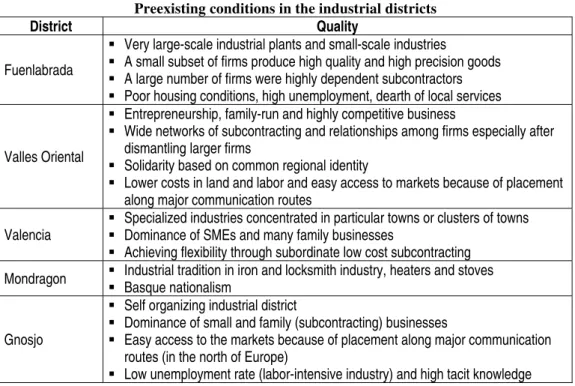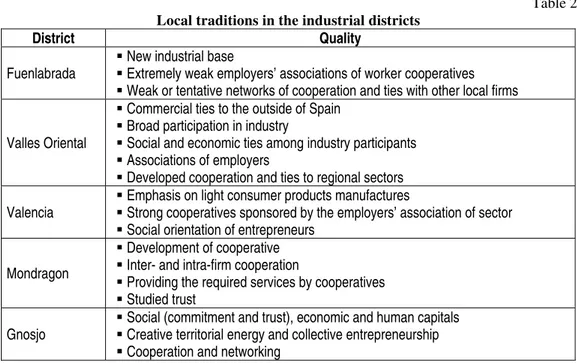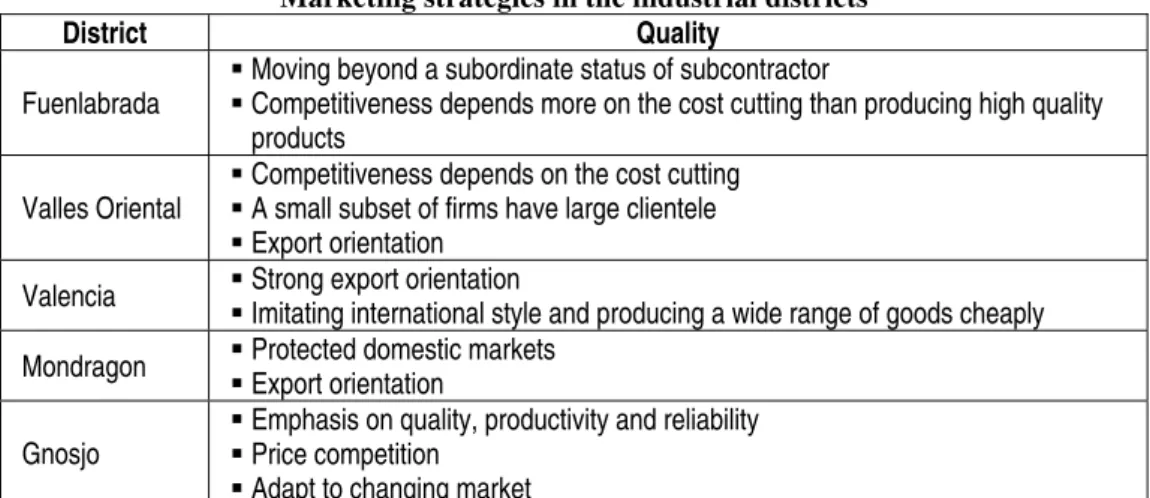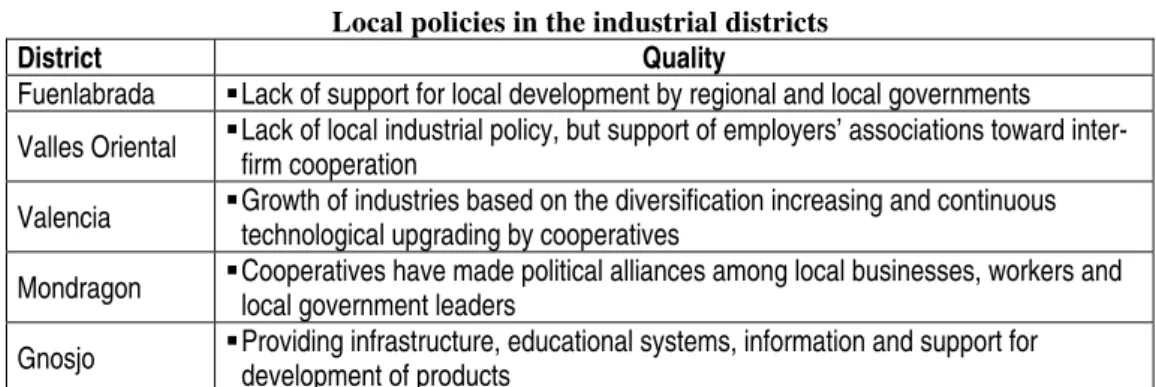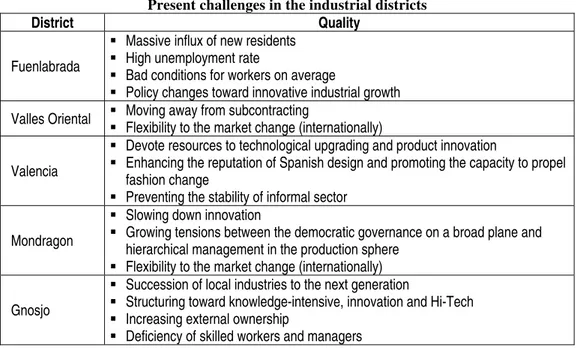Industrial District as a Corporation
Reza MOHAMMADY GARFAMY Semnan University, Iran garfamy@yahoo.com
Abstract. This paper provides a comparison study of industrial districts in two European countries, Spain and Sweden, using the conceptual framework of corporation. The relevance of this approach is based on the specific qualities that the industrial districts have, including the preexisting conditions, local traditions, products and production characteristics, marketing strategies, local policies and present challenges. The findings indicate the ways in which different patterns of inter-firm relationships, organization of production and dynamics of local alliances have shaped divergent regional responses to the industrial construction.
Keywords: industrial district, corporation, entrepreneurship, small and medium-sized enterprises (SMEs), transaction cost.
JEL Codes: D23, L14, L26, L52, O25. REL Codes: 17B, 17C.
1. Introduction
Industrial district phenomenon has been identified as a dynamic approach to the regional economic development. Although it is not a perfect model to solve all developmental problems, there are principles of organization by industrial district which can usefully be utilized in some contexts and countries.
An industrial district as a corporation is an infrastructure for human (inter)action, which penetrates most organizations in a society thereby changes and develops them and in long run is modified by them in an ever continuing process.
This paper briefly discusses the ways in which different patterns of inter-firm relationships, organization of production and dynamics of local alliances have shaped divergent regional responses to the industrial construction in Spain and Sweden. It begins with a look at the concept of corporation and then profiles some cases from the industrial districts in both countries. It thereafter presents an analysis of those industrial districts from the corporation perspective. This paper also suggests some directions for future policies to support the dynamic growth in the industrial districts.
2. Concept of corporation
Sjostrand (1992) identifies and defines the corporation as a basic theoretically deduced institution or infrastructure (a coherent system of shared norms) for human (inter)action which reduces the fundamental uncertainty and facilitates the effective and legitimate coordination of human actions in the society. The corporation is a phenomenon which coordinates, regulates and stabilizes the human activities and simultaneously functions as a resonance for change. In this respect, most efforts of a corporation are more process oriented so that individuals participate in the change. The social and/or economic change is continuously developing and it is discretionary. This process contains the (re)constructions of cognitive structures (e.g., orders, laws, codes, rules, habits, norms, agreements and patterns) and the habits of actions embedded (and embodied) in the corporation.
In most institutional analysis, the contract is used as a framework and the execution of that is carried out informally and in cooperation between the parties involved. Thus, the entire social context surrounding an exchange is of importance (Sjostrand, 1992). Three fundamental deficiencies in applying the idea of human interactions and exchanges as based on the contractual relations which have not been solved as yet according to Sjostrand (1992) are the problem of jurisdiction of social relations, lack of focus on dynamics and neglect of the existence of historical asymmetries (power differences).
Williamson (1979) recognizes the classical, neoclassical and relational categories of contract law in a three-way classification of contracts. He asserts that the critical dimensions for describing contractual relations are the uncertainty, frequency with which transactions recur and degree to which investments are idiosyncratic. He also describes six types of transactions to which the governance structures need to be matched. He proposes the market governance for classical contracting, trilateral governance for neoclassical contracting and transaction specific governance for relational contracting. In the last case, two types of transaction specific governance structures for intermediate production market transactions can be distinguished; namely, bilateral structure for obligational contracting and unified structure for internal organization. Nooteboom (1993) argues that Transaction Cost Economics (TCE) considers the effects of scale and scope on the costs of production, but hardly their effects on the costs of transaction. It also tends to ignore the effects of experience and learning and it has some limitations in the context of rapid innovation because it is not a dynamic theory. According to him, a transaction can be seen as an event during a process of exchange which consists of three stages; namely, contact, contract and control. Furthermore, the analysis of effects of firm size on the transaction costs indicates on the whole transaction costs are higher for smaller firm.
A hierarchy refers to the asymmetrical relationships between actors (individuals or entities) and it is characterized by the chains of relations of superiority and subordination and therefore by shifting some amounts of discretion (power) for actors in different levels.
Finally, in almost all organizations pervaded or infused by the logic of corporation, we also find both activities of (re)distribution and reciprocal relationships. Thus, according to Sjostrand (1992), the ideals manifested as rules or norms connected to the belief systems will affect the (inter)actions of individuals in the organizations as well as the friendship or other close relations.
3. Industrial districts in Spain
Spanish industries began the industrial restructuring process from a very different baseline in the midst of a global economic downturn and an internal political transformation. In this period, many sectors have restructured more out of economic necessity and cost cutting strategies from above than as a result of collective strategies from below to take advantage of new market opportunities, create alternatives to established forms of production or build on artisanal traditions or movements for local autonomy (Benton, 1992). At the first stages of restructuring, we can see the rapid growth of some new zones of industrial concen-tration of a large informal sector of off-the-books employment in mainly under-capitalized and not especially innovative new small firms, without the advantages of embeddedness in the supportive local communities such as the business associations and unions. The roots of these organizations among many constituen-cies are quite weak and have little influence over the restructuring process in small firms and in highly fragmented sectors. The political environment of transition did not favor policy supports for strengthening the industrial districts, too.
The combined effect of this institutional framework is the absence of strong leadership from local institutions to form alliances, which would underpin the emergence of dynamic industrial districts. The exceptions also reflect the wide differences in the social and political make-up of the regions in Spain.
We can identify two geographical patterns of change in Spain. First, the productive decentralization has been associated with a movement of industry away from the core and inner ring of major metropolitan areas, Madrid and Barcelona, and an expansion of an outer ring made up of a large numbers of small firms and multi-sector industrial zones. Second, many mono-sector rural- and town-based industrial concentrations have become consolidated. Benton (1992) argues that although productive decentralization has sometimes favored spatial diffusion, key industry functions such as commercial and financial services, auxiliary connections or recruitment of highly skilled workforce remained centralized in these potential industrial districts. Finally, the social and political identity of industrial districts, rather than merely their geographical setting or sector make-up, determines the direction of restructuring in these industrial districts.
The following cases present the development processes in the multi-sector industrial districts in Madrid and Catalonia as well as in the town-based mono-sector industrial districts in the Valencia and Basque regions.
3.1. Fuenlabrada in Madrid
Industrial growth in Madrid had been divided between very large-scale industrial plants, which were financed by national and international capital and small-scale industries, which served mainly the local market. Its industrial base was newer than that of Barcelona and the tradition of employers’ associations of worker cooperatives was extremely weak. The industrial structure in Madrid has been evolving away from subordinate forms of subcontracting and toward a more com-plex structure of interdependencies among small firms located on the periphery.
immediate environment, dearth of local services, weak or tentative ties with other local firms and little government support seemed crucial obstacles to the continued expansion of industries.
Madrid saw a rapid growth in the number of new small firms settling in the second ring of municipalities around the city in the period after 1978. A large proportion of firms were located on the land, which was still zoned for agricultural uses or makeshift industrial parks and that often lacked even basic infrastructural improvements such as paved roads, postal service and adequate water. A high percentage of firms were metalworking and woodworking shops with a diverse mix of other industries especially printing, food processing, graphic arts and chemicals. Findings about marketing strategies status also suggested that some firms were moving quickly beyond a subordinate status of subcontractor (Benton, 1992). The competitiveness of many firms as a subcontractor still often depended more on cost cutting than on an ability to produce high quality products in a flexible manner.
Fuenlabrada boasted the largest number of industrial establishments in the region after Madrid. Humanes, a neighboring town of still more recent industrial development, shows the highest industrial employment in the region. Here as elsewhere, the pressures of recession helped the formation of new small firms, but also operated against the consolidation of stable industrial areas in which the continuity of firms could support the development of cooperation networks. Nevertheless, it is significant that out of this tumultuous environment, a segment of highly innovative and successful firms have indeed emerged. It would seem that the zone is in fact serving as a cradle for some new enterprises, which are moving in the direction of more flexible production for widening markets in spite of either the local entrepreneurial culture or the support of local community.
Possibly as a result, cooperativism in the entire region has been very weak and followed mainly as a strategy for salvaging the jobs. The social and political institutions of the towns have yet to adjust to massive influx of new residents. The unemployment rate in the zone continues to be higher than the region as a whole and more significantly the conditions for workforce also appear to be worse on average.
3.2. Valles Oriental in Catalonia
The industries of Barcelona had a long-established tradition of commercial ties to the outside of Spain and produced a wider mix of consumer and intermediate goods. A tradition of family-run and highly competitive business was also already in place as was a tradition of associations of employers. The solidarity among industry participants might be based in part on the common regional identity. The textile industry of Spain has been heavily concentrated in Catalonia (most notably Sabadell and Terrassa) since the 18th century. The long-established presence of textile industry has also generated broad participation in industry and at times a cohesive workers’ movement. Finally, the industry has developed ties to other regional sectors most notably the chemical industry because of the growth of synthetic fiber production. These factors have helped establish a wide zone in and around Barcelona, which is characterized by a strong industrial tradition and pre-existing social and economic ties among industry participants.
The industrial structure in Barcelona is evolving away from subordinate forms of subcontracting toward a more complex structure of interdependencies among small firms located on the periphery. The local industrial policy has also been lacking, but employer associations have functioned to support the trend toward inter-firm cooperation. In addition, some peripheral communities have been among the leaders of the region in industrial growth.
Catalonia has emerged from the crisis period with its position as a leading industrial province firmly in place. This pattern features the relative rise of a group of intermediate regions, which tend to benefit from their lower costs in land and labor and their easy access to markets because of placement along major communication routes. This process of industrial diffusion has been accompanied by strengthening of sub-regional specialization as indicated by the relative growth of industrial investment. Finally, the region as a whole shows a substantial decline in average firm size as larger firms have been dismantled and replaced with streamlined enterprises, which engage in wider networks of subcontracting. These trends together suggest that a substantial restructuring of Catalonian industries is underway in part in reaction to new market conditions (Benton, 1992).
strengthening of its industry specialization in plastics and wood furniture products, metalworking, food processing and textiles. Finally, the networks of subcontracting and the relationships of cooperation among firms appear to be highly developed. Entrepreneurs clearly value the opportunity they have in Valles Oriental to work closely with both clients and suppliers. It is important to add that the dynamism displayed in Valles Oriental and other fast-growing regions in the last several years is owed at least in part to conjunctural factors. Particularly, with the entry of Spain into the European Economic Community, foreign investment has increased considerably. Foreign-financed firms may themselves take advantage of the dense network of small suppliers and subcontractors.
To summarize, Valles Oriental displays many of the characteristics of a successful industrial district; namely, a complex structure of relationships among firms, growing inter-firm cooperation and diversification and dynamism even during the worst years of industrial recession. Growth in this place in the last decade resulted from a more general pattern of productive decentralization, which drew investment away from the metropolitan core areas and the first ring of industrial centers toward the second less developed ring. This process at the same time favored the development of Small and Medium-sized Enterprises (SMEs) to allow for a diversified and flexible production.
3.3. Valencia region
Spanish design and promoting the capacity to propel fashion change rather than simply responding to it through imitation (Benton, 1992).
The industries of Valencia have reacted variably to this challenge and their responses tell us something about the viability of industrial districts as a supportive environment for this type of adjustment. We can look first at a highly dynamic and successful case, the ceramics producing region centered in a cluster of towns in the province of Castellon. The local institutions (cooperatives sponsored by the employers’ association of sector) have developed to enable the growth of industry based on the diversification increasing and continual technological upgrading. In contrast, the shoe industry centered in the province of Alicante has stalled in its effort to move the production into the higher price and higher fashion markets and it is now seeing its domestic market eroding under a rising tide of imports. Rather than diminishing, the informal sector has gained certain stability in Vinalopo Valley.
Despite increasing efforts on the part of the regional government to stimulate innovation in the industry, the dominant strategy remained one of achieving flexibility through subordinate low cost subcontracting. Even though the shoe producing towns display some of the same characteristics as the ceramics producing towns of Castellon, closer analysis shows crucial differences in the way the local industry responded to the crisis. The technological differences in production in two industries have something to do with their different responses at this conjuncture, but the social and political conditions in two communities are ultimately more important in explaining their divergent paths.
3.4. Mondragon in Basque
kind of organizational structure has permitted a certain degree of flexibility in responding to the market shifts and in developing the new ventures.
However, the innovation in this area has slowed down in recent years and the members of cooperatives express considerable frustration over what they perceive to be growing tensions between the democratic governance on a broad plane and the hierarchical management in the production sphere. Resolving such tensions may prove to be crucial to the ability of cooperatives to continue to respond flexibility to the market change particularly since future growth unlike past expansion will depend on their ability to serve more demanding international market rather than a protected and growing domestic market.
4. Industrial districts in Sweden
In regard to the situation of Sweden, it is of a considerable position in the world economy. Industries of Sweden have large firms on the top and small firms as a stand. What it comprehensively lacks is medium-sized businesses. The problem for Sweden and its large firms, according to Brulin (1998), is that they have not nourished a structure of supportive SMEs. There is a lack of creative territorial energy around many large firms and the Gnosjo region is an exception. The present challenge for Sweden is to make creative territorial energy to sustain and promote its industries. One of the favorite pastimes of industrialists and economists in Sweden is to moan about the lack of a Swedish entrepreneurial culture. What has maintained the dynamism of Gnosjo has been a constant emphasis on quality, high productivity and reliability, which are married to a strong family ownership tradition. The manufacturing strength of Gnosjo has naturally spawned a supporting service sector and a welter of trading firms, but there is less evidence of entrepreneurial culture perpetuating itself through the establishment of new firms.
4.1. Gnosjo region
The Gnosjo region is renowned for its distinctive business climate, which is referred to as spirit of Gnosjo and it is unique in Sweden. The local industries of the region in the county of Jonkoping are recognized by their small business and small-scale nature, which enable them to adapt quickly to the changing market requirements and new trends in the world. A similar industrial culture has pervaded nearby towns such as Anderstorp, Hillerstorp and Gislaved. The Gnosjo region comes top of the Swedish league table for growth alongside the Stockholm region with low unemployment rate. There is also a long tradition of cooperation and solidarity and of forming networks, which promote industrial success (Johannisson, 2002) and in turn lower transaction costs. It has a tight interaction between the social and economic lives where the specialized businesses are deeply embedded. The spirit of Gnosjo includes certain unique features, which makes it the lifeblood of the region (Johannisson, 2002, Wigren, 2003).
Karlsson and Larsson (1993) did a research about the long-run sustainability of the phenomenon of Gnosjo during the period 1980-1988. They found that the phenomenon of Gnosjo had not been as successful as expected. To sustain and improve the competitiveness of industries in the Gnosjo region in the long run, they suggested that the labor-intensive industries should be structured more in the knowledge-intensive direction. Brulin (1998) argues that bringing external partners into such a region like Gnosjo is not without any problem and proposes that external partners must not take over the process of territorial development thereby threatening to drain it of indigenously created energy.
The corporate structure of the Gnosjo region consists mainly of micro and small family-owned subcontractors primarily in the metal, plastic, wire and finishing industries. Its industries boast the production expertise and an impressive array of machinery and technological equipment. The automation and information technologies as well as the efficiency and effectiveness measures are well imple-mented and several firms in the region also have their own products in the global market. The level of on-the-job training and tacit knowledge is remarkably high, but the level of formal education is still low. The manufacturing, mining and quar-rying industry in Gnosjo is highly labor-intensive. The trade, transport and commu-nication sector and the health and social work sector are in the next positions.
firms were sold either to Swedish investment or venture capital firms or to foreign buyers and a number of firms also closed their factories down. The consequences of increasing external ownership of manufacturing businesses are causing changes in the economic and social lives of the region (Wigren, 2003).
In light of the ongoing restructuring trend, the demands on competitiveness and international recognition have rapidly intensified. Considering that most firms in Gnosjo are subcontractors in some form and only a small part survives based on a product of its own, there is every reason to review the potential of bringing more firms into the region, which have products of their own on the international market. Although the Industrial Development Center (a cooperative institution) and the municipality of Gnosjo are providing the necessary infrastructure, educational systems and information, there is not a mutually expressed regional strategy, which could be a guideline for public authorities to mold the infrastructure of the region.
In a traditionally strong classless society such as Gnosjo, the legal systems are highly substituted by shared ideals and genuine relationships. It reflects the stability or inertia in this society. However, legal rules of ownership and contracting are of great importance in global profit gaining and value adding business. The deeply rooted embedded formal and informal relationships based on trust (coherent system) in Gnosjo are creating a common understanding and are reducing the uncertainty in exchange and in turn the transaction costs, especially when the transactions are recurrent. The most common goals among the firms are of economic nature e.g., cost efficiency and the hierarchy in this corporation is exactly based on the power (technology, capital, information,…) of several stakeholders taking good care of their and others businesses.
5. Corporation perspective of industrial districts
To understand and compare the industrial districts in two countries, Spain and Sweden, using the conceptual framework of corporation, we distinguish and apply some specific qualities and compare the industrial districts based on these qualities. These specific qualities include the preexisting conditions, local traditions, products and production characteristics, marketing strategies, local policies and present challenges. Therefore, we discuss about the similarities and differences between these industrial districts, respectively.
5.1. Preexisting conditions
and family subcontracting businesses achieving flexibility through cost cutting is apparent in all industrial districts, although in Fuenlabrada, very large-scale industrial plants are populated and there is a small subset of firms, which produce high quality and high precision innovative goods. Among these industrial districts, only Valles Oriental and Gnosjo have easy access to the markets, because of placement along major communication routes, and high residential value. We can also find the low unemployment rate (labor-intensive industry) and high tacit knowledge in Gnosjo.
Table 1
Preexisting conditions in the industrial districts
District Quality
Fuenlabrada
Very large-scale industrial plants and small-scale industries
A small subset of firms produce high quality and high precision goods
A large number of firms were highly dependent subcontractors
Poor housing conditions, high unemployment, dearth of local services
Valles Oriental
Entrepreneurship, family-run and highly competitive business
Wide networks of subcontracting and relationships among firms especially after dismantling larger firms
Solidarity based on common regional identity
Lower costs in land and labor and easy access to markets because of placement along major communication routes
Valencia
Specialized industries concentrated in particular towns or clusters of towns
Dominance of SMEs and many family businesses
Achieving flexibility through subordinate low cost subcontracting
Mondragon Industrial tradition in iron and locksmith industry, heaters and stoves Basque nationalism
Gnosjo
Self organizing industrial district
Dominance of small and family (subcontracting) businesses
Easy access to the markets because of placement along major communication routes (in the north of Europe)
Low unemployment rate (labor-intensive industry) and high tacit knowledge
5.2. Local traditions
Table 2
Local traditions in the industrial districts
District Quality
Fuenlabrada
New industrial base
Extremely weak employers’ associations of worker cooperatives
Weak or tentative networks of cooperation and ties with other local firms
Valles Oriental
Commercial ties to the outside of Spain
Broad participation in industry
Social and economic ties among industry participants
Associations of employers
Developed cooperation and ties to regional sectors
Valencia
Emphasis on light consumer products manufactures
Strong cooperatives sponsored by the employers’ association of sector
Social orientation of entrepreneurs
Mondragon
Development of cooperative
Inter- and intra-firm cooperation
Providing the required services by cooperatives
Studied trust
Gnosjo
Social (commitment and trust), economic and human capitals
Creative territorial energy and collective entrepreneurship
Cooperation and networking
5.3. Products and production characteristics
The products and production characteristics of industrial districts in Spain and Sweden are summarized in Table 3.
It is obvious that all of them are specialized in consumer and intermediate goods production. Additionally, they have an impressive array of machinery and technological equipment and several different production lines so that the technological differences in production among them are apparent.
Table 03
Products and production characteristics in the industrial districts
District Quality
Fuenlabrada
Electronics, metalworking, woodworking, printing, food processing, graphic arts and chemicals
A segment of highly innovative successful firms
Valles Oriental
A wide mix of consumer and intermediate goods, textile, woodworking, metalworking, food processing and chemicals
Technology differences in production
Valencia Light consumer goods, ceramics, shoes, … Technological differences in production
Mondragon Home electrical appliances and several goods Several different production lines
Gnosjo Metalworking, chemicals and finishing industry
5.4. Marketing strategies
The marketing strategies made by different industrial districts are summarized in Table 4. Their competitiveness almost depends more on the cost cutting strategy than producing high quality products strategy and therefore the price competition is the main factor in this respect. Gnosjo is an exception, which focuses on the quality, productivity and reliability and adapts to the changing market. Fuenlabrada is moving beyond a subordinate status of subcontractor, but in Valles Oriental a small subset of firms still have a large clientele. Although Valencia is imitating the international style, it has a strong export orientation like Valles Oriental. Finally, Mondragon is still with its protected domestic markets.
Table 4
Marketing strategies in the industrial districts
District Quality
Fuenlabrada
Moving beyond a subordinate status of subcontractor
Competitiveness depends more on the cost cutting than producing high quality products
Valles Oriental
Competitiveness depends on the cost cutting
A small subset of firms have large clientele
Export orientation
Valencia Strong export orientation
Imitating international style and producing a wide range of goods cheaply
Mondragon Protected domestic markets Export orientation
Gnosjo
Emphasis on quality, productivity and reliability
Price competition
Adapt to changing market
5.5. Local policies
Table 5
Local policies in the industrial districts
District Quality
Fuenlabrada Lack of support for local development by regional and local governments
Valles Oriental Lack of local industrial policy, but support of employers’ associations toward inter-firm cooperation
Valencia Growth of industries based on the diversification increasing and continuous technological upgrading by cooperatives
Mondragon Cooperatives have made political alliances among local businesses, workers and local government leaders
Gnosjo Providing infrastructure, educational systems, information and support for development of products
5.6. Present challenges
Table 6
Present challenges in the industrial districts
District Quality
Fuenlabrada
Massive influx of new residents
High unemployment rate
Bad conditions for workers on average
Policy changes toward innovative industrial growth
Valles Oriental Moving away from subcontracting
Flexibility to the market change (internationally)
Valencia
Devote resources to technological upgrading and product innovation
Enhancing the reputation of Spanish design and promoting the capacity to propel fashion change
Preventing the stability of informal sector
Mondragon
Slowing down innovation
Growing tensions between the democratic governance on a broad plane and hierarchical management in the production sphere
Flexibility to the market change (internationally)
Gnosjo
Succession of local industries to the next generation
Structuring toward knowledge-intensive, innovation and Hi-Tech
Increasing external ownership
Deficiency of skilled workers and managers
6. Conclusions
The purpose of this study is to understand and compare the industrial districts in two European countries, Spain and Sweden, using the conceptual framework of corporation. The relevance of this approach is based on the specific qualities that the industrial districts have, including the preexisting conditions, local traditions, products and production characteristics, marketing strategies, local policies and present challenges.
In Spain, the relative weakness of local level institutions and tendency of firms to substitute short term cost cutting strategies for long term collective strategies have acted as a brake on the development of industrial districts. In Sweden, the lack of entrepreneurial culture, lack of encouragement for self-starters and lack of creative territorial energy around many large firms have led to the misshapen development of industries.
other aids, which will help firms develop and contribute to the innovation in industry. Concerning policy implications for these regions, we can propose the improvement of competitive advances by recognizing the exchange related issues, enhancing educational systems, developing the possibilities of bootstrapping and tax reduction of succession to the next generation for local family firms and embedding international firms into the local formal and informal networks.
As Benton (1992) said, the centrally or globally industrial plan is not likely to reach entrepreneurs and workers in SMEs, which comprise the largest segment of emerging industrial districts. Policy makers should explore the ways by which their actions can contribute to building a political atmosphere, which will be conducive to inter-firm cooperation, participatory and flexible organization of labor inside the firms, and to strengthening of local level alliances in support of these trends.
References
Benton, L. (1992). „The emergence of industrial districts in Spain: Industrial restructuring and diverging regional responses”, in Pyke, F. and Sengenberger, W. (eds.), Industrial Districts and Local Economic Regeneration, Geneva, International Institute for Labor Studies
Brulin, G., „How to shape creative territorial energy: The case of the Gnosjo region”, Concepts and Transformation, 3, 3, 1998, pp. 255-269
Johannisson, B. (2002). „Den Heliga Gnosjoandan”, Wired at <www.ehv.vxu.se/ forskn/entreprofil/publikationer.html>
Karlsson, C., Larsson, J., „A Macro view of the Gnosjo Entrepreneurial Spirit”,
Entrepreneurship and Regional Development, 5, 2, 1993, pp. 117-140
Nooteboom, B., „Firm size effects on transaction costs”, Small Business Economics, 5, 4, 1993, pp. 283-295
Rock, M., „Found: Europe’s business hotspots”, Director, 49, 3, 1995, pp. 48-55
Sjostrand, S.-E., „On the Rationale behind Irrational Institutions”, Journal of Economic Issues, XXVI, 4, 1992, pp. 1007-1040
Wigren, C. (2003). The Spirit of Gnosjö: The Grand Narrative and Beyond, Jonkoping, Jonkoping International Business School
Williamson, O.E., „Transaction cost economics: The governance of contractual relations”,
